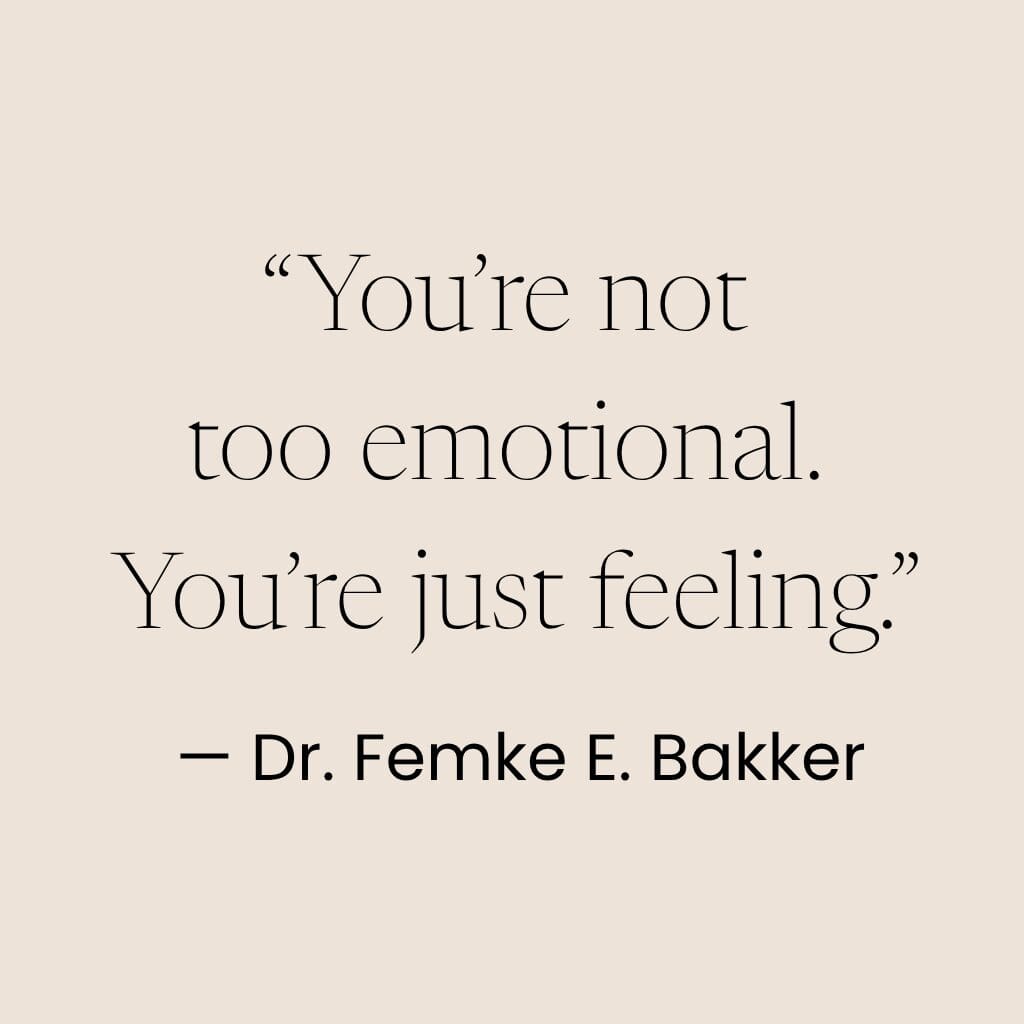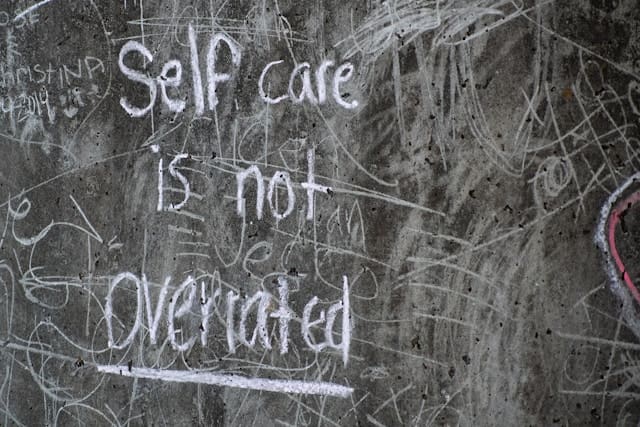By Dr. Femke E. Bakker
You probably know that moment. A wave of emotion hits you, grief, irritation, shame, fear, and your first instinct is to make it stop. You try to solve it, suppress it, explain it, or simply push through. And maybe no one even notices, because you’re so good at keeping it together on the outside.
But inside, you feel disconnected. Exhausted. Overwhelmed. And you ask yourself why you’re so very emotional, because it keeps you from functioning ‘normally’. You wish you were like everyone else, who seem to hold it all together.
If that sounds familiar, you’re not alone. And please know: there’s nothing wrong with you.
What if dealing with an emotion on the spot would prevent them from piling up?
Emotions can feel inconvenient, messy, overwhelming. Even as someone who teaches selfgentleness, I still have moments where my emotional life feels too much. I’ve to consciously allow myself to feel, to be emotional whenever I catch myself trying to control or tidy the emotions up.
Because emotions aren’t meant to be controlled. They’re meant to be felt.
And yet, many of us, including myself, weren’t taught how.
Already at a young age, I learned to push them away. To reason them away. To feel ashamed when sadness or anger wrestled themselves through my control. Over the years, I did my utmost best to toughen up, to perform strength, to move on. Especially because others called me “too emotional,” “too sensitive,” or “too much.”
But you know what? Ignoring your emotions doesn’t make them go away. It just makes them louder and stronger over time.
Why we disconnect from our emotions (and how to come back)
Let’s break this down for a moment. You can distinguish between feelings and emotions:
- Feelings are raw, physical sensations in the body.
- Emotions are the meanings and stories we attach to those sensations.
Let’s say someone interrupts you in a meeting. Your sense how your throat tightens. That’s a feeling. Then the thoughts arrive: “Why don’t I speak up? She always does this. I’m pathetic.” That’s the moment you give meaning to those feelings. That’s emotion.
Imagine this: what if we could pause before the story in our head starts?
Research by Dr. Joan Rosenberg suggests that if you stay present with the raw feeling, without fueling it with thoughts or judgment, most emotions pass within 60 to 90 seconds. They might return, but as long as you keep your attention to the physical sensations in your body, they will again peter out in about a minute. That insight changed my own relationship with emotions.
When I speak about this process in my Selfgentleness Lives, I compare these emotional waves with waves of the ocean. When it storms, the waves are high and strong. As the wind decreases, the waves will slowly peter out until the ocean is flat again. Being in the middle of an emotional storm is just the same. The better you learn to surf these waves by letting them come and go, not fighting them, not building them with stories, just being present here and now with how these feel in your body, the quicker you’ll experience how they slowly decrease in power and peter out.
How emotional waves can become emotional tsunamis
But if you add stories to them, you pile those waves up. They turn into tsunamis, which will remain stuck in your body until that moment – sooner or later – when something insignificant happens and suddenly the tsunami of emotions breaks down on you.
Dealing with emotions is not about control. It’s about allowing the physical sensations of the emotions to exist in the moment, and trust that these feelings will decrease. And so will the emotions and the stories. The more often you allow yourself to feel without fixing, the more resilient you become.

How to deal with emotions in a selfgentle way
This is how it works:
1. Catch the moment before the spiral
The next time you notice an emotion rising, take a moment. Put your hand on your chest or belly. Breathe. Ask yourself:
- Where in my body do I feel this?
- Can I let this be here for 60 seconds, just as it is?
You don’t need to label it. You don’t need to solve it. Just stay with the bodily sensations.
2. Let the feeling move without making it mean
Let it be ok to experience these feelings. Yes, it can feel unpleasant. But that’s ok. It’s ok to feel. To experience how tears drop from your eyes. How your body feels flashy. You aren’t falling apart. It only takes 69-90 seconds. And then you’ll feel a bit better. Emotions are energy in motion. If you give them space to move through you, they will slowly decrease in intensity.
What you can do to support yourself:
- Take a walk, preferably in nature
- Shake your hands, your arms, your buttocks
- Lie down and let yourself cry, hold and comfort yourself
- Exhale as long as feels comfortable, through your mouth
The goal is not to “get rid of” your emotions, but to let them flow, so they don’t get stuck and build up.
3. Choose selfgentleness over self-criticism
When emotions come, it’s easy to judge yourself. “Why am I feeling this?!” “I should be stronger.” But what if you said to yourself what you would say to a dear friend or a child:
“It’s ok to cry, you’re ok. I’ve got you.” “You’re just feeling. Nothing wrong with that.” “Hey darling, I’m here. I’m so proud of you right now.”
It might feel a bit weird to speak to yourself like that initially. But once you try it, you’ll experience that you’re building emotional resilience. Next time, you’ll know better how to support yourself. And that shifts something important in you. The deep knowing that you can be as you are. In any moment.
Emotional resilience isn’t the same as never feeling emotions anymore
Knowing how to deal with your emotions doesn’t mean constant inner peace. You’ll still experience unpleasant emotions. However, the difference will be that you’ll allow your emotions to surface so you can process them. In other words, you will not be afraid of your own inner world anymore.
So, when sadness shows up, you make space. When you feel angry, you find a way to process it without doing or saying things you later might regret. And when joy bubbles up, you let yourself feel it fully without the fear it will end.
Over time, you’ll begin to recognize: Your emotions aren’t the enemy. They’re just part of you.
Try This: Emotion Surfing (Printable Practice)
If you’d like to work with your emotions in a way that’s simple, tangible, and selfgentle, I’ve created a printable guide of the practice above you can keep nearby.
The Emotion Surfing Sheet walks you through 5 selfgentle steps to move through emotional waves without shutting down or spiraling.
- A step-by-step practice to meet your emotions as sensations, not problems
- A selfgentle map to support yourself without needing to fix anything
- Based on neuroscience-backed insight: emotions last 60–90 seconds when unfed by thought
You can download it here → Download the Emotion Surfing Sheet
Selfgentleness is radically accepting yourself as the most important person to consistently deserve your own gentleness. Read more about selfgentleness in this article.
If this article resonated with you, feel free to share it. And if you want to know when my next article is published, use the form below to let me know you want a heads up in your inbox.
Be selfgentle,
All love, Femke





